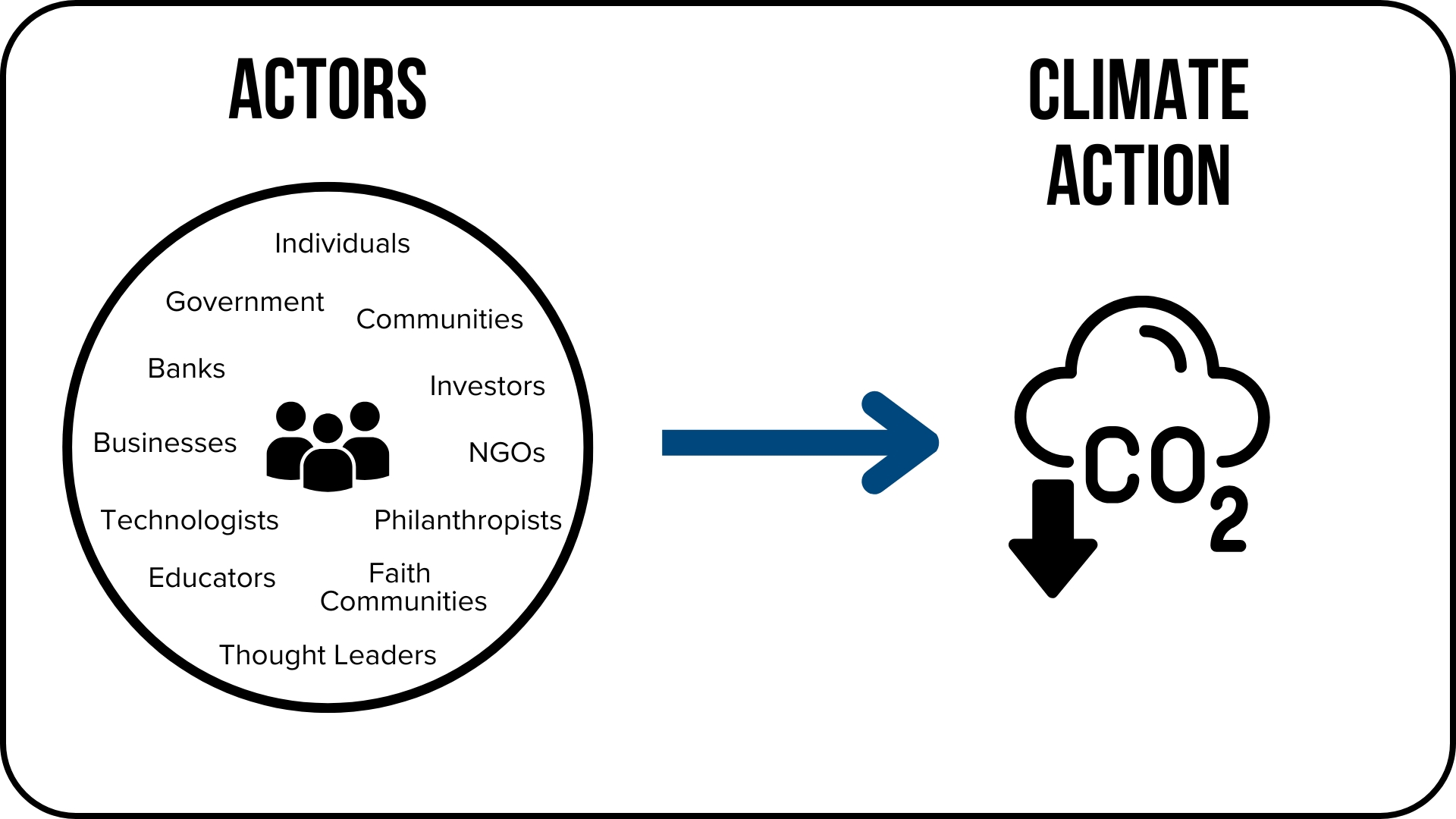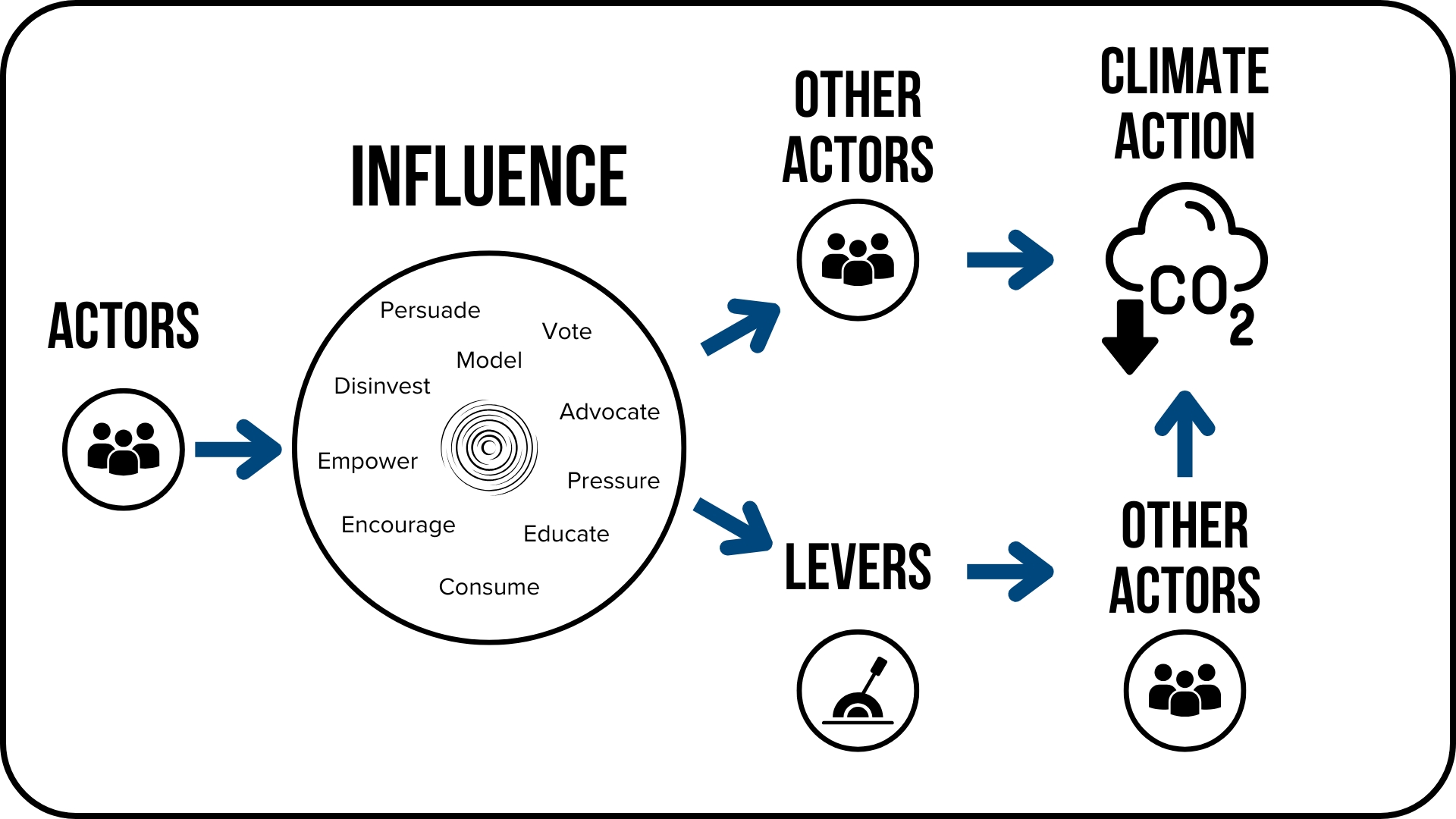All of us have many pathways to climate action
by Christina (Tina) Swanson, Ph.D.
A recent conversation with a friend got me thinking another way about the “who” and the “how” of climate action.
My friend is deeply concerned about climate change and has already taken actions to reduce her own emissions, including installing rooftop solar panels and switching to an electric car. She works to minimize her consumption and food waste, and she donates to environmental organizations and climate-aware politicians. But with the impacts of climate change becoming increasingly apparent and devastating, she still felt she should be doing more. And so, she asked me, as a climate scientist and friend, what else she could do.
After applauding her incredible efforts, I suggested that perhaps she was thinking too narrowly about the problem and about the full impact of her actions.
Climate action is not just about what you can do. It is about what we can do. When you look at it that way, the universe of “how” we can all take action to solve climate change becomes bigger and, I would argue, brighter.
To paraphrase an old proverb, it’s going to take a village. Indeed, the only way we can succeed in stopping climate change is by approaching our task as a multi-faceted, collective, and collaborative endeavor. Embrace this concept, and each of us has more power, more influence, and more ways to take climate action than we might think.
Climate change is both a people problem and a systems problem. The greenhouse gases accumulating in our atmosphere come from human activities – our homes, our food, how we get around, how we make things, and how we power all these aspects of our lives. But these activities are also embedded within the societal, economic, and cultural systems that we live in, from our dietary choices and local small businesses to our global market economy and government policies. That’s why most of the actions we must take to halt and reverse climate change will take more than the efforts of any single person, entity, or sector of society.
There are three interrelated steps we must take to activate and harness the power of our global village to drive climate action. First, we need to identify who in our village is best positioned to take – and benefit from – which actions to reduce emissions. Second, we need to strategically change existing systems to favor climate action, rather than impede it. And finally, we must use the many pathways available to each of us to influence others to take climate action and shape the broader systems of which we are all a part.
1. Many Actors, Many Actions
Like my friend, when we envision climate action, we tend to think of steps we can take to directly reduce our own emissions. We also tend to think that our actions won’t have much impact on a global problem like climate change. But remember, there are a lot of us who care about climate change, and there are lots of actions – big and small – that each of us can take.
For example, as an individual, you can take public transit to work instead of driving a gas-powered car, shift to a plant-rich diet, or cut back on air travel. Businesses can convert their vehicle fleet or equipment to electric, upgrade their buildings and factories with efficient heat pump systems, or switch to suppliers with documented emissions reduction commitments. Farmers can plant cover crops to increase soil carbon or improve fertilizer management to reduce nitrous oxide emissions. My organization, Project Drawdown, reduces its staff transportation emissions by operating a 100% remote workplace. The opportunities for effective action that directly reduce emissions are as numerous and diverse as the many actors in our global village.
Here is another example. In East Oakland, California, the Allen Temple Baptist Church recognized that their commitment to environmental justice and climate action intersected with their role as a community center for service and engagement. To ensure that their building could provide a safe, resilient, and comfortable place even during extreme weather and power outages, they installed solar panels and backup batteries to power the church’s classrooms, industrial kitchen, offices, and gym. This action reduced Allen Temple’s power- and building-related emissions while saving an estimated US$20,000 in utility bills annually. Furthermore, the impact of the project likely extends beyond the church and its congregation: Research shows that solar installations on prominent non-residential buildings, including churches, can motivate nearby residents to install solar on their homes.
But also consider this – the decision by the church to take this climate action, and its ability to do so, did not happen in a vacuum. Support from other actors like Green the Church, a coalition of Black faith and environmental justice groups that promotes community resilience, and donated labor and equipment encouraged and enabled the project. Thus, the church’s action to reduce its emissions was also a collaborative enterprise with other actors – the “we” in climate action – that also continues to return benefits to the village beyond its climate impact.
2. Strategically Change Systems
Beyond direct action to reduce emissions, there are “levers” we can pull to make strategic interventions in social, economic, industrial, and governmental systems. Changing the systems that currently support or perpetuate carbon-intensive activities is essential for unlocking and scaling up climate action. Done right, these systemic actions can encourage, enable, or compel other actors to reduce their emissions.
For example, banks and investors can pull the finance and funding lever by shifting lending and investment toward the clean energy sector and away from carbon-intensive sectors like the oil and gas industry. The regulation lever, usually pulled by government and public policy actors, can incentivize or compel action to change climate-harming practices, such as the Renewable Portfolio Standard established by North Carolina that requires a 70% reduction in carbon dioxide emissions from electricity generating facilities by 2030. The strategic climate litigation lever, pulled by regional and municipal governments, non-governmental organizations, and concerned citizens, can, even when the lawsuit is not successful, advance climate policy, transform government or corporate behavior, and raise public awareness. Project Drawdown works to pull the public outreach lever to inform and enable action by other actors, like Carbon Collective, which uses the Drawdown Roadmap to help people direct their investments toward climate solutions.
In Sweden, a mining company, a steel producer, and an energy companycollaborated to pull the technology and innovation lever with the aim of fundamentally changing the iron and steel industry. Combining their respective expertise, products, and facilities, they developed and successfully piloted a process to produce fossil fuel-free steel. Interest in this new technology is high, and the climate-friendly steel produced by the project is already being used in vehicles, heavy machinery, buildings, and consumer products. This strategic intervention has changed the industrial landscape and social license to operate for an industry that currently contributes 7% of global greenhouse gas emissions.
3. Influence Others
All actors can influence the actions of others in many ways. Whether it’s showing another actor how to take climate action or pressuring them to pull a lever to change a system that is impeding progress, these indirect climate actions are both important and, once you start looking for them, ubiquitous.
For example, in addition to voting, individuals can advocate for climate action to their elected representatives, utility providers, or homeowners associations. Consumers, businesses, and investors can pressure corporate actors to decarbonize their value chain by redirecting their money toward more climate-friendly products and businesses. Thought leaders can educate and inspire, building and empowering communities of informed, engaged actors who can then themselves take or drive more effective action. In my own family, installing a heat pump in my home undoubtedly influenced my sister and brother-in-law to follow suit.
Lisa Feldman, Senior Director of Culinary at Sodexo, a multinational food service provider, was influenced to take action by a compelling conference speaker who explained the connections between food and climate change. Inspired, she partnered with the speaker to launch the Food For Climate League, a non-profit whose mission is to make climate-smart eating the norm. She then took this mission to her employer, determined to use her influence to persuade Sodexo to adopt more climate-friendly menus. Her persistence paid off with the development of the Sodexo Future Food Collective and an initial goal for a new business norm (a lever) to increase the availability of plant-based meals on college menus.
As with the other examples, Lisa’s path to climate action – and her impact – illustrates the potential reach and power of climate actors wielding their influence to inspire, initiate, support, and even magnify climate action by others.
So, to my friend – and to all of us – let’s think more expansively about what constitutes impactful climate action, about who can take what kinds of actions, and about how we can work together to drive the changes we need. By matching the right actors to the right actions, pulling the right levers to create systemic change, and using our influence to shape the behavior of others, we can aim higher and reach further toward a thriving future.
Each of us has not one but many roles we can play. Climate change is a big problem, but we live in a big, vibrant, creative village. Together, we can accomplish more than you might think.
Here are more resources about the many ways you can take climate action:
-
Beyond voting, here’s how to take citizen action for the climate | Project Drawdown
-
Employee Climate Action Guide • A Guide for Employee Advocates • ClimateVoice
-
Climate change is real, most climate experts agree – Science Moms
-
Standing up for science and climate action, now more than ever | Project Drawdown
-
From the White House to COP: Where does climate policy go from here? | Featuring Dan Jasper
Christina (Tina) Swanson, Ph.D., is an environmental scientist with a background in cross-disciplinary research, multi-faceted engagement at the interface of science and policy, and an enduring passion to turn science into action to solve environmental problems and benefit society.
This work was published under a Creative Commons CC BY-NC-ND 4.0 license. You are welcome to republish it following the license terms.



